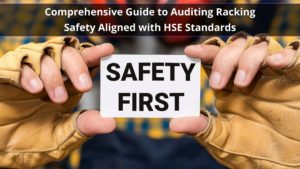
Almost two years after the November 2014 SEMA safety conference, some people still believe that straightening damaged uprights is a safe way to repair racking. That just isn’t true.
We have long believed that SEMA safety conferences are extremely important to the world of warehouse safety. The build up to a SEMA safety conference, the events of a SEMA safety conference, and what follows after a SEMA safety conference can lead to big changes to warehouse and racking safety.
In a technical bulletin released in October 2014, one month before that year’s SEMA safety conference, SEMA made this statement about repairing damaged uprights by straightening them:
“With regards to any repair methods that claim there is no need to offload pallets in order to carry out the repair, SEMA’s opinion is that this is a high risk procedure and advises that such claims run counter to HSG 76 recommendations.”
The statement is as logical as it is unambiguous: racking cannot be repaired by straightening. Moreover, any repair method which is performed without the racking being offloaded contradicts HSG 76 (Warehousing and Storage: A Guide to Health and Safety). In this authoritative guide from HSE, the advice is crystal clear:
“Where damage is identified that affects the safety of the racking system, the racking should be offloaded and controls introduced to prevent it being used until remedial work has been carried out.”
Why do SEMA and HSE advise against repairing damaged uprights by straightening them?
Straightening damaged uprights is very dangerous for two reasons.
Firstly, carrying out any repair that affects a racking system without first offloading the racking massively increases the risk of a racking collapse. While offloading an entire racking system can take a lot of time, not offloading a racking system when it needs repairing can — and sometimes does — lead to workplace fatalities.
When racking is damaged to the extent that it is visibly bent and misshapen, it needs to be offloaded immediately. This is what HSE identify as a “red risk”. To leave the racking system loaded and to embark on repairs while knowing the system is damaged is a completely unnecessary gamble. If disaster were to happen, if someone were to die as a result of an employer not offloading a racking system which they knew full well was damaged, it would be entirely the employer’s fault. This is made clear with new CDM regulations’ definitions of client responsibility. From both a moral and a legal standpoint, trying to repair racking that has not been offloaded is just wrong.
Secondly, repairing an upright by using hydraulic equipment to straighten doesn’t work. No racking manufacturer claims that it would work and SEMA has outright stated that it doesn’t work.
Rather, SEMA argue that straightening damaged uprights makes them weaker. They argue that it leads to metal fatigue and they recommend the replacement (not the repair) of uprights that have been bent. When uprights are straightened, the original racking system has been modified and — in doing so — it voids the manufacturer’s warranty, the carrying capacity, and the safety guarantee.
Damaged uprights need to be replaced, not repaired. And, of course, for the damaged upright to be replaced, all stored items in the area of the damaged racking system need to be offloaded.
If SEMA and HSE’s safety advice is so clear, why is there still confusion?
Less than one year after SEMA categorically denounced straightening pallet racking uprights as “high risk”, ROS UK appeared in Warehouse News, claiming to have patented a specific kind of service: straightening pallet racking uprights.
In the article, it states that ROS UK can repair racking “without the need to unload a single pallet or product”.
So why is it that a business like ROS UK are able to offer this service when both HSE and SEMA agree that racking cannot be repaired until the system has been offloaded?
In part, the reason for this is HSE’s new CDM regulations. The 2007 regulations meant that the responsibility for the safety of a workplace, building site, or design project was shared by the “client” (the employer or contractor) and HSE itself. By contrast, the new CDM regulations (introduced in 2015) mean that the onus of responsibility is solely on the client.
In other words, HSE’s role is to advise the client on safety; it is the role of the client to ensure that safety is carried out. And so, if a client decides to hydraulically straighten their uprights in order to repair them, they are perfectly entitled to do so.
However, they do so entirely against both SEMA and HSE’s recommendations and, if tragedy happens and the racking collapses, they will have no-one to blame but themselves. HSE’s new CDM regulations mean that HSE are no longer at fault when clients go against their advice.
ERF Steps in with a New Storage Equipment Bulletin
In an attempt to make matters even clearer than they are already, ERF (the European Racking Federation, also known as FEM) released a storage equipment bulletin in March 2016. The bulletin contains this direct warning about straightening damaged uprights:
“This method of repair is not currently recommended by any racking manufacturers”
SEMA are a British member of the ERF and, as such, they are in agreement with them on many racking issues. The danger of straightening of uprights is yet another issue on which SEMA and ERF agree.
In short, SEMA, the ERF, and HSE do not recommend straightening damaged uprights. And neither do we.
Are your uprights in working condition? Contact us now for a rack safety inspection. As a SEMA approved racking inspector, we respect SEMA’s opinions on safety and always recommend that bent uprights are replaced, not repaired.





